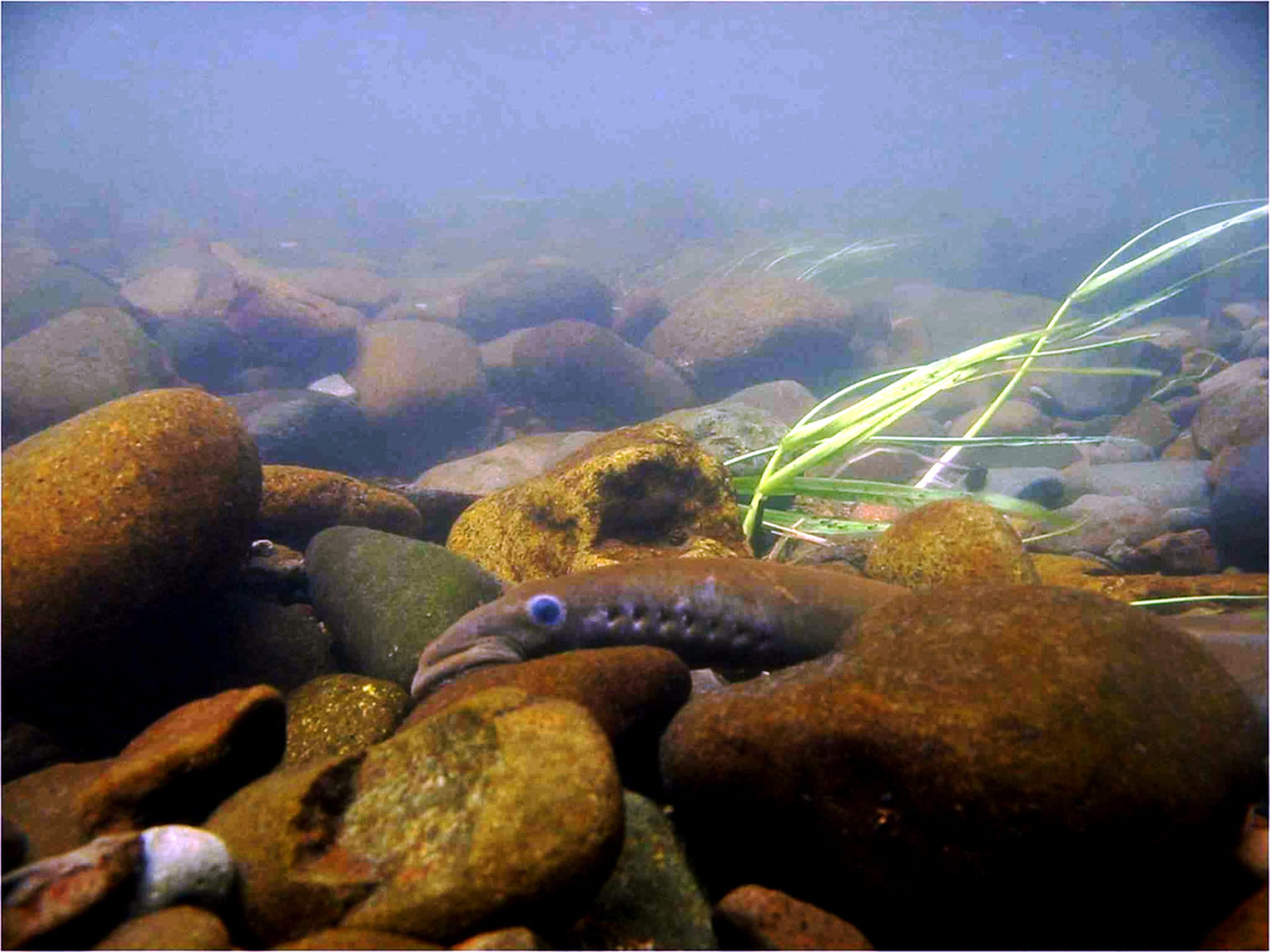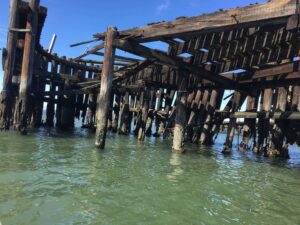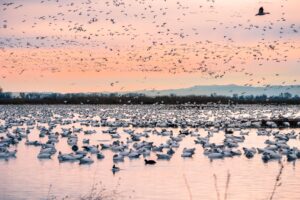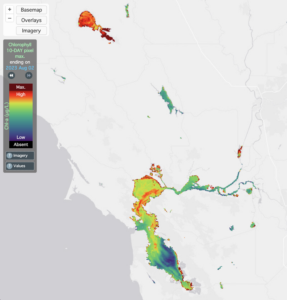Cape Horn is a concrete and earth-filled dam on the upper Eel River in Mendocino County. About 140 miles north of San Francisco, the dam was built in 1907 and blocks the waters of the Eel to form the Van Arsdale Reservoir. Part of the Potter Valley hydro-electricity project along with the Scott Dam 11 miles further upstream, the project stores winter run-off from the Eel River basin for drinking water and power generation. Much of its diverted water ends up in another river entirely, forced south through a series of aqueducts and canals and power turbines to the East Fork Russian River.
Though it’s the smaller of the two dams on the Eel, the Cape Horn Dam is still over 90 feet high. To its side is the oldest fish counting station in California, the Van Arsdale Fisheries Station, run by the California Department of Fish and Game since 1922. The station overlooks a fish ladder, built as part of the agreement to allow construction of the Scott Dam, which allows fish like salmon and trout to travel upriver to spawn.
Unfortunately, from the beginning it also overlooked, and not in the scenic way, the needs of the lamprey, a much-maligned fish that also needs access to the Eel’s headwaters and unlike its salmonid cousins can’t swim up a ladder. It was a disregard more egregious here than anywhere in the lampreys’ long range along the Pacific Northwest because the river is actually named after lampreys, which early European settlers mistook for eels.
The adult Pacific lamprey (Entosphenus tridentata), largest of the six species native to California, grows about 2 feet long. And in this David-meets-Goliath scenario, the little guy doesn’t make it.
“When you go to the ladder in the daytime, you might see an occasional lamprey hanging on the wall. But when you go to the bottom of the fish ladder at 11 o’clock at night, the walls are covered with lampreys trying to get up this fish ladder,” said Stewart Reid, a private freshwater fish biologist. “But nobody is really out looking.”
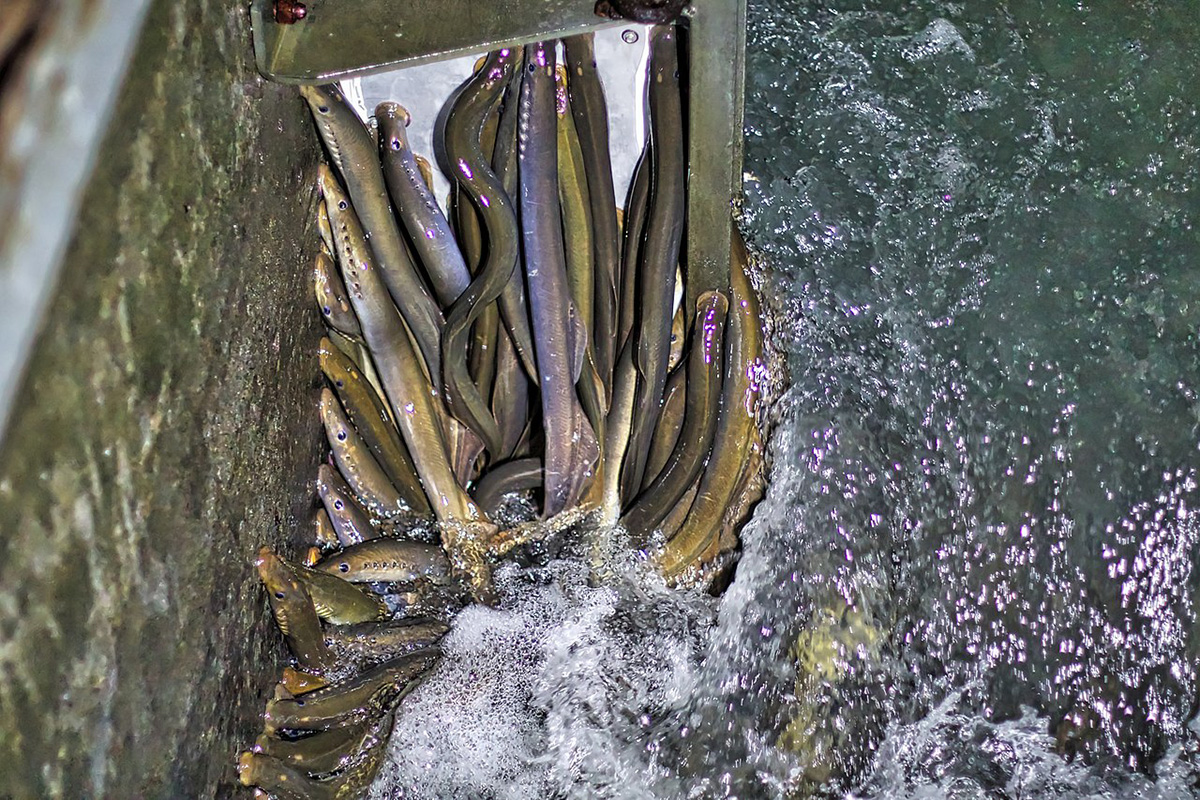
Evolved from the first-known vertebrates, the lamprey has been on many a Halloween list and villainous YouTube video, and even inspired some B-grade horror films. Like the well-known salmon and trout, Pacific lamprey are anadromous fishes, meaning their eggs hatch in streams but adults travel out to sea before returning to freshwater to spawn. But they differ from other anadromous fish in that they have no scales, jaws or paired fins. Instead, these long grayish-black fish have breathing holes along their sides instead of gills, and a sucker mouth with many small teeth-like-structures in them that enable them to latch onto their prey and suck out nutrition, giving them the unflattering moniker of “vampire” fish.
But for all of their evolutionary kinks, which have helped the blue-eyed vertebrate survive for around 450 million years on the planet — including the unique way they climb barriers; whole body undulating, creating waves that propagate them ever onward and upward — they didn’t account for people, and 90-foot-high smooth, cement walls. While lampreys can latch onto vertical, wetted walls like waterfalls with their oral disc and use suction to move, dams and 90-degree angles are beyond them.
“It was taking three weeks for a lamprey to get to the top of the fish ladder, and only 10 percent were making it successfully, with the rest falling back,” Reid said. To help them up, Reid and fellow biologist Damon Goodman came up with an inexpensive, low-tech solution in 2016 — a good old-fashioned plastic tube. Four inches in diameter, the flexible plastic tube has enough water to keep it wet, snaking 250 feet around the whole structure. “And now it takes the lampreys three hours to get over the dam. In 2017, we had over 11,000 lampreys go over the top,” Reid says. “When you’re a lamprey biologist, you can’t confront problems — you have to find ways to get around them, like the lampreys themselves.”
The stop-gap ladder, though ingenious, is symptomatic of the problem plaguing lampreys — they have historically been seen by settler cultures as a nuisance at best, and pests at worst. “Since colonization, there’s been this divide of aquatic organisms into ones that we care about, and ones that we don’t — ones that we just arbitrarily classify as pest fish,” says Grace Auringer, a graduate student at UC Davis who studies lampreys. “And unfortunately, lamprey got a bad reputation and were classified as pests, probably in part because of their appearance.”
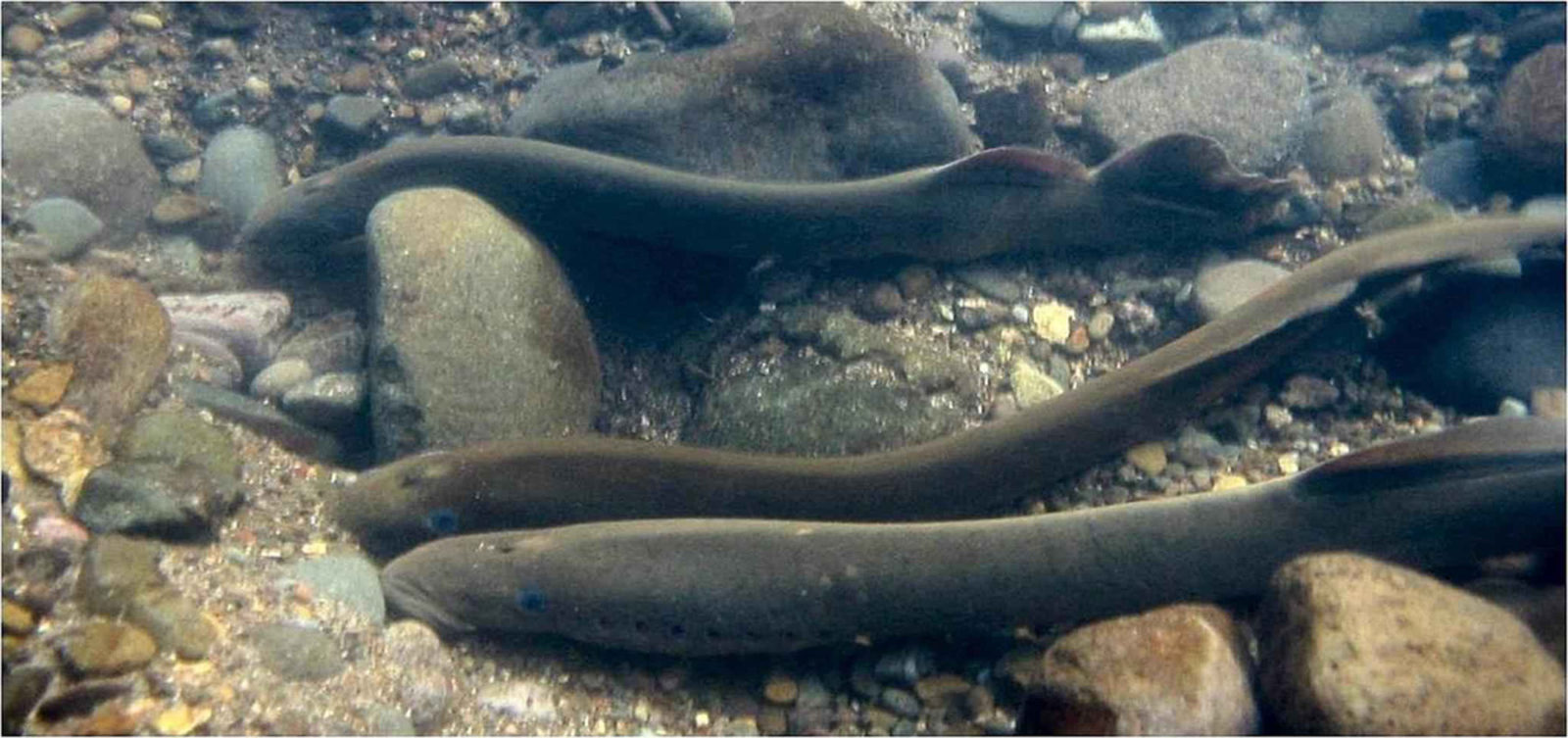
Formidable-looking or not, lampreys have been and continue to be an important source of food and of cultural and medicinal significance to Pacific Northwest tribes. But beginning in the late 1800s, as Euro-Americans began to focus on salmonids as prime food and sport fish, other native fishes began to be seen as less valuable or “junk” fish.
Once abundantly distributed in streams along the Pacific Ocean from Baja California north to the Bering Sea in Alaska, lamprey populations have declined or become locally extinct in many parts of California, Oregon, Washington and Idaho, especially upriver from barriers like dams. In California, the current distribution is approximately half of the species’ historic range.
Maps produced by the California Department of Fish and Wildlife show three species of lamprey — Pacific, river, and Western brook — in San Francisco Bay, but researchers don’t rule out the possibility that it holds even more species diversity. Two of these, the Pacific and river lamprey, are migratory, while the Western brook lamprey is a resident. “The ancestral version of this fish, the more prehistoric version, was migratory. But throughout time, probably as their habitats have been modified across the globe, non-migratory forms have evolved,” Auringer says. “Those are generally referred to as brook lamprey.”
Brook lampreys are not parasitic, and grow much smaller than Pacific or river lampreys. One place where the Western brook lamprey can be found, though it often gets misidentified as juvenile Pacific lamprey, is Alameda Creek in Fremont.
Freshwater records suggest that Pacific lamprey were once present across the Bay Area in drainages more than 225 square kilometers in area, in rivers and creeks including the Sonoma, Napa, Pacheco, Alameda, Coyote, Guadalupe and possibly even the Suisun watershed. Today they can be found in Lagunitas Creek in Marin; the Russian River, Gualala River and Dry Creek in Sonoma; Walnut Creek in Contra Costa; the Guadalupe River in San José; and San Francisquito creek in Palo Alto. And even though navigating passage and dewatering or low flow in rivers has been a major threat to them in California, there have been sightings of lamprey migrating as far upstream to spawn as the Sunol regional wilderness.
Ironically, despite their “pest” reputation, the presence of lampreys in estuaries and rivers reduces predation on salmon and trout by bigger animals and birds like the bald eagle, sea lions or the river otter, and offers these predators as well as the salmonids themselves a food source that is incredibly rich in fat.
They are so important that Auringer calls the fish unsung heroes of the coastal ecosystem. Because they are filter feeders during the first three to nine years of their life, they repeatedly burrow in the fine sediment found along stream margins, and eddies and pools in search of food. “They kind of sit there with their mouths open,” Auringer says, “and feed on detritus, like skin cells that have fallen off other fish, and poop even.”
This burrowing and nutrient cycling increases oxygen availability in the water, ramps up the primary productivity of the whole system and maintains the health of the streams.
“When people walk out into the river bed, and put their toes into the sand, they aren’t aware that there may be a concentration of up to 50 ammocoetes, or larval lampreys, in one square meter of sand in the rivers of California,” Reid says. “Lampreys are often the highest biomass in a stream, living down in the substrate.”
Once they are ready to travel to the ocean, juvenile Pacific lampreys move downstream in response to river discharge, often during late fall, winter and early spring. In a study that Reid and Goodman undertook at Red Bluff, on the Sacramento River, they noticed that the critical period for lampreys to move out to sea was within two days of peak flow. “When we think about how to manage water, this gives us a tool to say when we don’t want water in the river diverted,” Reid says.
Unfortunately once they do reach salt water, we don’t know a lot about what happens to them. While the building of dams restricted their habitat, offshore fishing might have also depressed their food base. “We don’t really understand these dynamics because we rarely see lampreys out there. But one of their prey items is certainly hake, and when we discovered how to make fake crab meat out of hake, suddenly, the fishery for hake skyrocketed,” Reid says. He says this might be associated with the decline in the lamprey population as well.
The ones that make it spend anywhere from six months to three years in the ocean before they begin a journey back. Like salmon, migratory lamprey help nutrition to flow from the ocean to freshwater, because they bring marine-derived nutrients back with them when they swim upstream to spawn and then die. These nutrients that come from the ocean are critical not only for the vitality of freshwater ecosystems and the aquatic organisms that live in them, but also birds and animals that feed on lamprey carcasses. “[The nutrients] seep into the soil, and are really good for vegetation as well,” Auringer says. “In fact, some people say the redwoods wouldn’t exist if lamprey didn’t exist.”

For all that we have to thank them for, there’s still a lot we don’t know about lampreys — like how abundant they really are, as well as their sensitivity to factors like drought and temperature. Though they are pretty resilient, having evolved strategies to survive a veritable variety of conditions over 450 million years, climate change will affect several factors they rely on, including ocean and stream conditions and water quality.
One study in 2017 found that larval lamprey were able to survive in temperatures as high as 80.5 F, but couldn’t stay alive very long when it was greater than 84 F. While the temperature information suggests that water temperatures might not be a huge constraint into the future by itself, higher temperatures means increased algal blooms and a reduced oxygen load in the sediment, which, Reid says, is very bad for lamprey. Drought, and water availability is a more present danger. One study suggests that larval lamprey can survive in a dry stream bed for up to 22 days as long as there is a little bit of water. But as we take more water out of our rivers and groundwater and pump it into agriculture and household use, the water availability drops below the level of the riverbed. Reid cites Salinas as an example — when lamprey try to move out on a big rain, they follow the water to the lower end of the river, but then it dries up and they never make it to Monterey Bay. Climate change is already exacerbating drought conditions in the Western United States, with the last two decades being the most extreme megadrought in at least 1,200 years. “Lamprey have demonstrated an amazing capacity to adapt to environmental change over the millions of years they’ve been around, but as climate change gets more and more dramatic, we’re not sure how much they [lampreys] can actually take,” Auringer says.
Even as they suffer dramatic population declines across the West Coast, funding for research and conservation efforts remains elusive, and largely focused further north. There is currently also no established lamprey monitoring in California, and the lack of both — solid data sets and funding — creates a lamentable chicken and egg situation.
One collaborative effort to fix more attention on the species has been the Pacific Lamprey Conservation Initiative (PLCI). A collaboration of Native American tribes, federal, state, municipal and local agencies, and non-governmental organizations, the Initiative is trying to “achieve long-term persistence of Pacific Lamprey, their habitats, and support their traditional tribal use throughout their historical range spanning the West Coast of North America.” In a three-pronged process, agencies assess, come up with agreements for conservation, and implement them regionally. In 2017, under the aegis of the PLCI, Reid and Goodman worked on a regional implementation plan for the San Francisco Bay Regional Management Unit, and the biologists have also populated and maintained a California distribution database since.
In the Klamath River basin, the Yurok have also done extensive work to conserve lamprey. In 2019, Keith Parker, a biologist with the Yurok Fisheries Department, discovered two new subspecies of Pacific lamprey, underscoring the necessary first step of spending more time around the fish to know what they are and how they live. In Washington, an experimental hatchery is underway.
In February this year, Auringer began working on a two-year project funded by the California Sea Grant that will use genomic tools to understand lampreys better. She intends to use these tools to fill ecological gaps — lamprey movements across barriers, developing genetic markers to distinguish between species and identifying genetically distinct lamprey units. Sites of focus will include dams throughout the San Francisco Bay, Sacramento, and San Joaquin watersheds.
In another win for lampreys in February, federal regulators issued a draft environmental statement that the plan to demolish four large dams on the Klamath River to save salmon had significant benefits. A final draft could be issued as early as this summer, after public hearings, clearing the way for the largest dam removal in United States history.
And back in the Potter Valley, the fight over the Scott and Cape Horn dam is heating up as well. In 2019, PG&E gave up its interest in the hydroelectricity project, allowing the Federal Energy Regulatory Commission to invite new licensees for ownership.
Many now hope that the Scott Dam will be demolished, but its future remains unknown — much like the lamprey’s.

